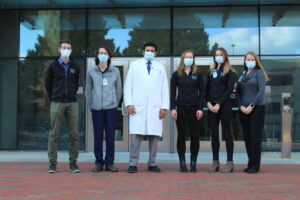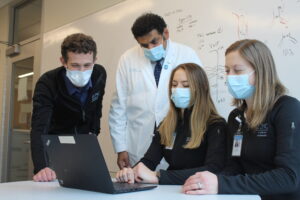March is Deep-Vein Thrombosis (DVT) Awareness Month, a public health initiative that seeks to aid understanding of a commonly occurring and potentially life-threatening medical condition among the general population. DVT is commonly referred to as a blood clot (thrombus) that forms in one or more veins located deep inside the body. Did you know, almost one in four people don’t know about blood clots or their signs and symptoms?
DVT typically develops in the leg, although it can occur elsewhere, and it essentially blocks normal blood circulation. This condition can be very serious because blood clots in the deep veins can break off, travel through the bloodstream and become lodged in one of the blood vessels in the lungs. This is known as a pulmonary embolism (PE) and requires emergency treatment because it can have fatal consequences.The Division of Hematology and its affiliated Blood Research Center are involved in a number of key thrombosis related trials, including a national COVID trial.

Hematology Leads Clinical Trial Serving COVID Patients, UNC is Highest Enrolling Site Worldwide.
Studies have shown the importance of treating hospitalized COVID patients with blood thinners. They show that non-ICU patients with COVID benefit from this treatment. But how long does the risk for blood clotting continue after the hospitalization? When COVID patients are discharged to recover at home, they may still be experiencing shortness of breath or using oxygen, while managing other symptoms. Raj Kasthuri, MBBS, professor of medicine in the division of hematology, and his team are participating in a clinical trial designed to compare the effectiveness and safety of antithrombotic therapy with no antithrombotic therapy, after hospitalization for COVID related illness.
“In this trial, we are randomizing people to receive a preventive blood thinner versus placebo, for 30 days after discharge. We know that treatment with blood thinners in non-critically ill patients during the hospitalization is beneficial. What we want to determine is if there is a benefit to continuing them on some protection while they’re recovering at home.”

Designing the Trial
In this NIH sponsored study (NINDS, NHLBI, BARDA, OWS, HHS), approximately 5300 patients are being enrolled at 200 sites around the world. UNC Hematology has enrolled over 90 patients, the largest single site enrollment in the trial. The study’s primary objective is to determine the most effective and safest antithrombotic strategy to prevent the composite outcome of symptomatic deep vein thrombosis, pulmonary embolism, other venous thromboembolism, ischemic stroke, myocardial infarction, other arterial thromboembolism, all of which can cause mortality by 30 days following hospital discharge.
“We recruit patients that have been in the hospital for greater than 48 hours, who don’t have any clotting disorders, and are not already on an anticoagulation agent,” said Research Coordinator Katie Stanford. “Before discharge, I visit them in person, explain the study and consent them. When they leave, they have the 30-day supply of study drug to start taking.”
Participants are then followed for an additional 60 days after the completion of treatment for a total duration of 90 days. The team hopes to show that the patients who were randomized to get the blood thinner for 30 days do better and have fewer complications after discharge.
Identifying Patient Participants
Research Program Supervisor Brett Phillips recognizes that the success of the trial depends on a strong partnership with hospital staff, which includes Andrew Campbell, MD, and other hospitalists who are on the frontlines taking care of COVID patients in-house.
“There’s a system for screening all patients admitted to the hospital with COVID, and every day the staff works collaboratively with the hospitalist team to identify the right patients. We couldn’t do this without a close collaboration. Foot traffic is limited to minimize exposure on the inpatient side. With so many serving in the pandemic, in various ways, it is rewarding to able to serve patients and help prevent a complication that they may have.”
Research Coordinator Laura Finerty says patients agree to join clinical trials for different reasons. But for this one, the reason is always the same. “They want to do it because they want to help the cause. They see it is as fighting back against the virus.”
In addition to this COVID thrombosis trial, there are a number of other clinical and laboratory research efforts on thrombosis that are ongoing at the UNC Blood Research Center. Clots formed in veins are rich in a protein called fibrin that acts like a net to hold the clot together. There are many proteins in the clotting cascade. These can be divided into 3 parts: extrinsic, intrinsic and common pathways of blood clotting. Current anticoagulant drugs for treatment of blood clots target proteins in the common pathway. These drugs are effective but increase the risk for bleeding. The intrinsic pathway has recently become the focus of much research because targeting this instead of the common pathway may decrease the risk for bleeding. Basic science research studies conducted at the UNC Blood Research Center suggest that factor XI in the intrinsic pathway may be a good target for preventing DVT/PE. Indeed, two recent clinical trials demonstrated that reducing levels of factor XI or inhibiting its activity reduced DVT/PE in patients with less bleeding than a currently used anticoagulant. These results are very encouraging and suggest that new, safer anticoagulants may be available soon to prevent the devastating effects of DVT/PE.